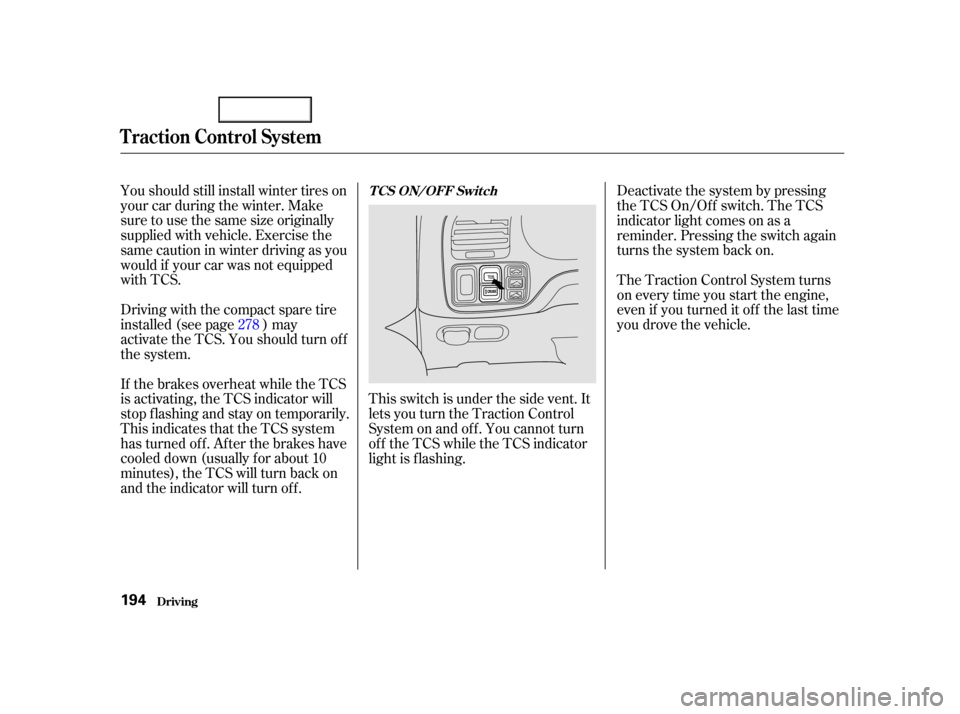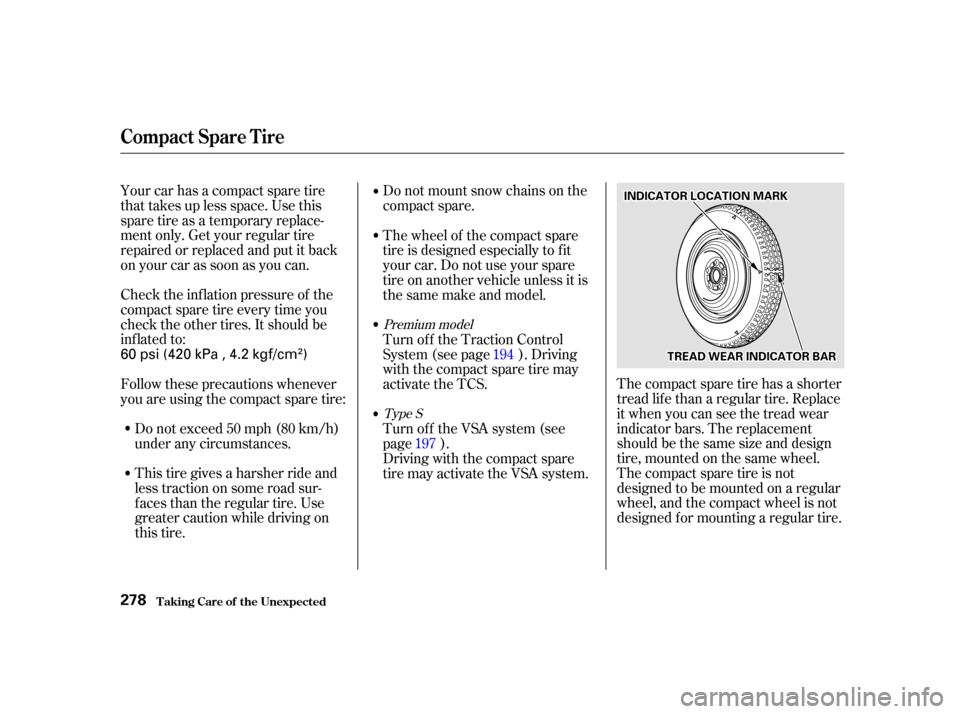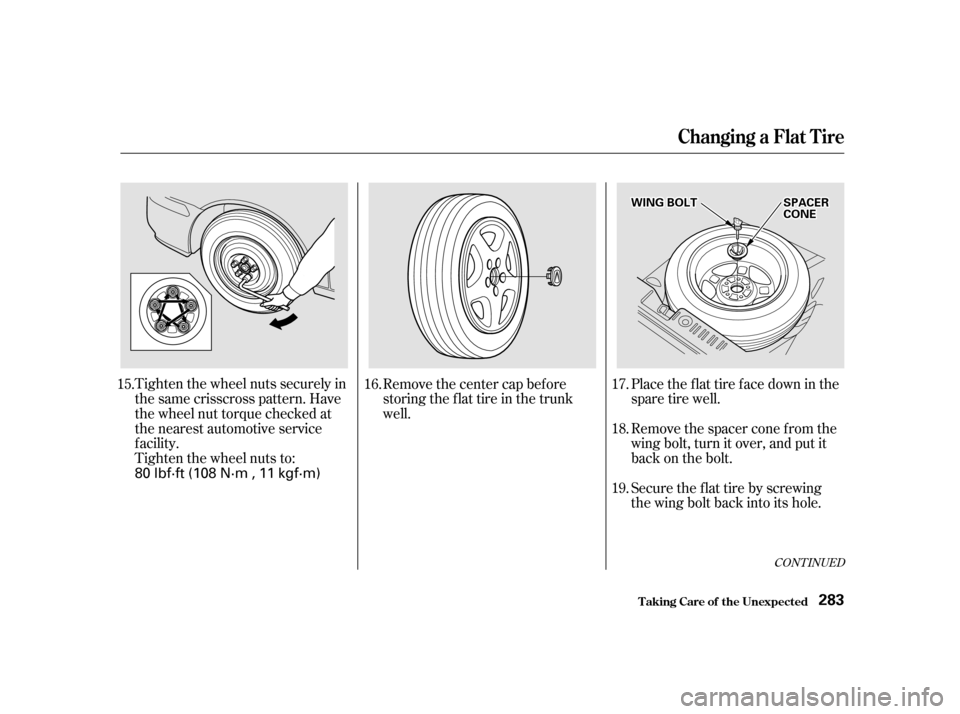spare tire Acura TL 2002 3.2 Owner's Manual
[x] Cancel search | Manufacturer: ACURA, Model Year: 2002, Model line: TL, Model: Acura TL 2002Pages: 339, PDF Size: 4.71 MB
Page 197 of 339

You should still install winter tires on
your car during the winter. Make
sure to use the same size originally
supplied with vehicle. Exercise the
samecautioninwinterdrivingasyou
would if your car was not equipped
with TCS.
Driving with the compact spare tire
installed (see page ) may
activate the TCS. You should turn of f
the system.
If the brakes overheat while the TCS
is activating, the TCS indicator will
stop flashing and stay on temporarily.
This indicates that the TCS system
has turned of f . Af ter the brakes have
cooled down (usually f or about 10
minutes), the TCS will turn back on
and the indicator will turn of f .This switch is under the side vent. It
letsyouturntheTractionControl
System on and of f . You cannot turn
of f the TCS while the TCS indicator
light is f lashing.Deactivate the system by pressing
the TCS On/Off switch. The TCS
indicator light comes on as a
reminder. Pressing the switch again
turns the system back on.
The Traction Control System turns
on every time you start the engine,
even if you turned it of f the last time
you drove the vehicle.
278
Traction Control System
Driving
TCS ON/OFF Switch
194
00/12/25 14:25:20 31S0K630_197
Page 201 of 339

VSA is turned on every time you
start the engine, even if you turned it
off the last time you drove the car.Driving with varying tire or wheel
sizes may cause the VSA to
malf unction. When replacing tires,
make sure they are of the same size
and type as your original tires (see
page ).
Deactivate the VSA system if you
need to drive with the compact spare
tire installed (see page ).
If you install winter tires, make sure
they are the same size as those that
were originally supplied with your
car. Exercise the same caution
during winter driving as you would if
your car was not equipped with VSA. 254
278
VSA and Tire Sizes
Vehicle Stability Assist (VSA) System
Driving198
00/12/25 14:25:59 31S0K630_201
Page 208 of 339

When preparing to tow, and bef ore
driving away, be sure to check the
f ollowing:The vehicle has been properly
serviced, and the tires, brakes,
suspension, and cooling system
are in good operating condition.
All weights and loads are within
limits (see pages and ).
Allitemsonandinthetrailerare
properly secured and cannot shif t
while you drive.
Many states and Canadian provinces
require special outside mirrors when
towing a trailer. Even if they don’t,
you should install special mirrors if
you cannot clearly see behind you, or
if the trailer creates a blind spot.
Askyourtrailersalesorrental
agency if any other items are
recommended or required f or your
towing situation.
The lights and brakes on your
vehicle and the trailer are working
properly.
Your vehicle tires and spare are
properly inf lated (see page ),
and the trailer tires and spare are
inflated as recommended by the
trailer maker.
Thehitch,safetychains,andany
other attachments are secure. 201 202 252
Pre-T ow Checklist
Additional Trailer Equipment
Towing a Trailer
Driving205
00/12/25 14:27:07 31S0K630_208
Page 254 of 339

We recommend that you visually
check your tires every day. If you
think a tire might be low, check it
immediately with a tire gauge.Use a gauge to measure the air
pressure at least once a month. Even
tires that are in good condition may
lose one to two psi (10 to 20 kPa, 0.1
to 0.2 kgf /cm ) per month.
Remember to check the spare tire at
thesametimeyoucheckallthe
other tires.
Keeping the tires properly inf lated
provides the best combination of
handling, tread lif e and riding
comf ort. Underinf lated tires wear
unevenly, adversely af f ect handling
and f uel economy, and are more
likely to f ail f rom being overheated.
Overinf lated tires can make your car
ride more harshly, are more prone to
damage f rom road hazards, and wear
unevenly. If you check the pressure when the
tires are hot (the car has been driven
several miles), you will see readings
4 to 6 psi (30 to 40 kPa, 0.3 to 0.4
kgf /cm ) higher than the cold
reading. This is normal. Do not let
air out to match the specified cold
pressure. The tire will be
underinf lated.
Youshouldgetyourowntire
pressure gauge and use it whenever
you check your tire pressures. This
will make it easier f or you to tell if a
pressure loss is due to a tire problem
and not due to a variation between
gauges.
Check the pressure in the tires when
they are cold. This means the car
has been parked f or at least three
hours. If you have to drive the car
bef ore checking the tire pressure,
the tires can still be considered
‘‘cold’’ if you drive less than 1 mile
(1.6 km).
CONT INUED
Inf lation
Tires
Maint enance251
00/12/25 14:34:41 31S0K630_254
Page 255 of 339

The following chart shows the
recommended cold tire pressures f or
most normal driving conditions and
speeds. Tire pressures f or high
speed driving are the same as f or
normal driving.Every time you check inf lation, you
should also examine the tires f or
damage, f oreign objects, and wear.
Youshouldlookfor:
Bumpsorbulgesinthetreador
side of the tire. Replace the tire if
youfindeitherof theseconditions.
Cuts, splits, or cracks in the side
of the tire. Replace the tire if you
can see f abric or cord.
Excessive tread wear.
Thecompactsparetirepressureis:
These pressures are also given on
thetireinformationlabelonthe
driver’s doorjamb.
Tubeless tires have some ability to
self -seal if they are punctured.
However, because leakage is of ten
very slow, you should look closely
for punctures if a tire starts losing
pressure.
Cold Tire Pressure
for Normal Driving
Tire Size
Tire Size Cold Tire Pressure
for Normal Driving
Type S
Premium model
Recommended T ire Pressures f or
Normal Driving
Inspection
Tires
Maint enance252
P205/60R16 91V 32 psi (220 kPa ,
2.2 kgf/cm
)
P215/50R17 93V 32 psi (220 kPa , 2.2 kgf/cm
)
60 psi (420 kPa , 4.2 kgf/cm)
00/12/25 14:34:57 31S0K630_255
Page 280 of 339

This section covers the more-
common problems that motorists
experience with their vehicles. It
gives you inf ormation about how to
safely evaluate the problem and what
to do to correct it. If the problem has
stranded you on the side of the road,
you may be able to get going again.
If not, you will also f ind instructions
on getting your car towed.......................
Compact Spare Tire . 278
....................
Changing a Flat Tire . 279
..........
If Your Engine Won’t Start . 285
Nothing Happens or the Starter Motor Operates ............................
Very Slowly . 285
The Starter Operates ................................
Normally . 286
................................
Jump Starting . 286
............
If Your Engine Overheats . 289
.........
Low Oil Pressure Indicator . 291
..........
Charging System Indicator . 292
.......
Malf unction Indicator Lamp . 293
.......................
Readiness Codes .294
...............
Brake System Indicator . 295
..................
Closing the Moonroof . 296
..............................................
Fuses .297
..........
Checking and Replacing . 298
......................
Emergency Towing .302
Taking Care of the Unexpected
T aking Care of t he Unexpect ed277
00/12/25 14:39:17 31S0K630_280
Page 281 of 339

Thecompactsparetirehasashorter
tread lif e than a regular tire. Replace
it when you can see the tread wear
indicator bars. The replacement
shouldbethesamesizeanddesign
tire, mounted on the same wheel.
Thecompactsparetireisnot
designed to be mounted on a regular
wheel, and the compact wheel is not
designed f or mounting a regular tire.
Check the inf lation pressure of the
compact spare tire every time you
check the other tires. It should be
inf lated to: Your car has a compact spare tire
that takes up less space. Use this
sparetireasatemporaryreplace-
ment only. Get your regular tire
repaired or replaced and put it back
on your car as soon as you can.
Follow these precautions whenever
you are using the compact spare tire:
Do not exceed 50 mph (80 km/h)
under any circumstances.
This tire gives a harsher ride and
less traction on some road sur-
f aces than the regular tire. Use
greater caution while driving on
this tire. Do not mount snow chains on the
compact spare.
The wheel of the compact spare
tire is designed especially to f it
your car. Do not use your spare
tire on another vehicle unless it is
thesamemakeandmodel.
Turn off the Traction Control
System (see page ). Driving
withthecompactsparetiremay
activate the TCS.
Turn of f the VSA system (see
page ).
Driving with the compact spare
tiremayactivatetheVSAsystem.
194
197
Type S
Premium model
Compact Spare Tire
T aking Care of t he Unexpect ed278
I IN
ND DI
ICCA A T
TO
OR R L
LOOC CAA T
TI
IOON N M
MA
AR
RKK
T
T R
RE EA
A D
D W
WE EA
A R
R I
INND DI
ICCA A T
TO
OR R B
BAA R
R
60 psi (420 kPa , 4.2 kgf/cm)
00/12/25 14:39:30 31S0K630_281
Page 282 of 339

If you have a f lat tire while driving,
stop in a saf e place to change it.
Stopping in traf f ic or on the shoulder
of a busy road is dangerous. Drive
slowly along the shoulder until you
gettoanexitoranareatostopthat
is far away from the traffic lanes.Open the trunk. Raise the trunk
f loor by lif ting up on the back edge.
To keep the trunk f loor out of the
way, attach the hook into the slot
in the trunk lid.
The tools are in the tool box on
the right side of the trunk. Take
the tools out of the tool box. Unscrew the wing bolt and take
the spare tire out of its well.
Park the car on f irm, level, and
non-slippery ground away f rom
traf f ic. Put the transmission in
Park. Apply the parking brake.
If you are towing a trailer, unhitch
the trailer.
Turn on the hazard warning lights
and turn the ignition switch to
LOCK (0). Have all the
passengers get out of the car while
you change the tire. 5. 4. 3.
2. 1.
CONT INUED
Changing a Flat T ire
T aking Care of t he Unexpect ed279
T T
O
OO OLL B
BOOX X
H
H
O
OO OKK T
T
R
RU UN NKK F
FLLOOO ORR
S
SP PA
A R
REE T
TI
IRRE E J
JA
A C
CKK
The car can easily roll off the
jack, seriously injuring anyone
underneath.
Follow the directions for
changing a tire exactly, and
never get under the car when it
is supported only by the jack.
00/12/25 14:39:43 31S0K630_282
Page 285 of 339

Put on the spare tire. Put the
wheel nuts back on f inger-tight,
then tighten them in a crisscross
pattern with the wheel wrench
until the wheel is f irmly against
the hub. Do not try to tighten
them f ully.
Bef ore mounting the spare tire,
wipeanydirtoff themounting
surface of the wheel and hub with
a clean cloth. Wipe the hub
carefully,itmaybehotfrom
driving.
Lower the car to the ground and
remove the jack.
12.
13. 14.
T aking Care of t he Unexpect ed
Changing a Flat T ire
282
B BRRAA K
KEE H
HU
UB B
00/12/25 14:40:10 31S0K630_285
Page 286 of 339

Tighten the wheel nuts securely in
the same crisscross pattern. Have
the wheel nut torque checked at
the nearest automotive service
f acility.
Tighten the wheel nuts to:Place the flat tire face down in the
sparetirewell.
Remove the spacer cone f rom the
wing bolt, turn it over, and put it
back on the bolt.
Securetheflattirebyscrewing
the wing bolt back into its hole.
Remove the center cap before
storing the f lat tire in the trunk
well.
15.
16. 17.
18.
19.
CONT INUED
Changing a Flat T ire
T aking Care of t he Unexpect ed283
W WIINNG G B
BOOL LTT S
SPPA
A C
CEER
R
C
CO ON NEE
80 lbf·ft (108 N·m , 11 kgf·m)
00/12/25 14:40:21 31S0K630_286